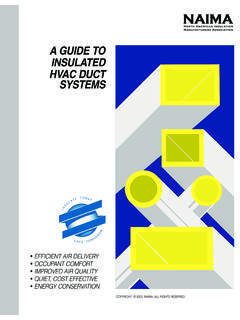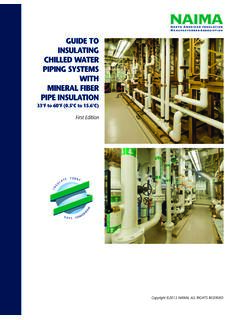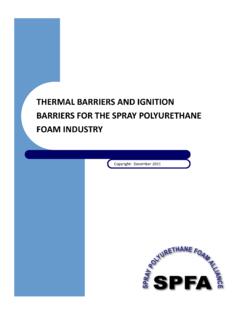Transcription of Maximum Thickness Restrictions For Spray Foam
1 The Monthly Newsletter on Energy-Efficient Housing Electronically reprinted from Vol. 28, No. 4 April 2008. Maximum Thickness Restrictions For Spray Foam Most contractors and building inspectors appear to 6 inches Maximum in ESR-1383 (BioBased 501), be unaware that the technical specifications for Spray 2 inches Maximum in ESR-1615 (Insulstar), polyurethane foam (SPF) products often include maxi- 6 inches Maximum in ESR-1172 (Sealection 500), but mum Thickness limitations. Since buildings insu- only inches Maximum for attic walls, lated with the listed Maximum Thickness of Spray inches Maximum in NER-420 ( icynene ), but foam often fail to meet minimum prescriptive R-value 6 inches in certain attic constructions, requirements, builders who learn of these limitations 2 inches Maximum in ER-3974 (Froth-Pak).. are often surprised and confused.
2 Hogan continued, It is worth noting that, in the IECC. The Maximum Thickness confusion is complicated by and the energy chapter of the IRC, the attic insulation the fact that product specifications often list two differ- requirements for all climate zones are never less than ent limitations on foam Thickness : a Maximum thick- R-30 and in the colder climates reach R-38 and R-49. ness per pass during installation of the Spray foam, and Consequently, none of these Spray foam insulation a Maximum cured-foam Thickness arising from code- products would comply with the prescriptive require- mandated flame-spread tests. ments for attic insulation when used individually. Further, the wall insulation requirements for the colder Maximum Thickness May Be Only 2 Inches climate zones are R-19 or R-21. Consequently, some of To prove to local building officials that Spray foam these Spray foam insulation products would also not meets code requirements, most SPF manufactur- comply with the prescriptive requirements for wall ers have had their products evaluated by the insulation when used individually.
3 International Code Council Evaluation Service (ICC-ES). After conducting a product evalua- Maximum Thickness Is Still Too Thin tion, ICC-ES employees summarize their findings Maximum Thickness limitations can be found not in an Evaluation Service Report (ESR). Although only in Evaluation Service Reports, but also in manu- these ESRs often convince local building officials to facturers' specifications for SPF products. Most of approve the use of Spray foam, they have increased these limitations are written in such a way that they rather than reduced confusion over Maximum raise more questions than they settle (see Maximum Thickness limitations. Thickness Limitations For Cured Foam ). Among the unanswered questions: How can builders use Spray The uncertainties over the meaning of Maximum thick- foam when prescriptive code requirements call for ness limitations were highlighted in a public letter from insulation with an R-value that exceeds the Maximum John Hogan, the senior code development analyst for Thickness ' listed in manufacturers' documents?
4 The Seattle Department of Planning and Development. In his January 23, 2007 letter to the ICC-ES Evaluation According to James Andersen, the manager for applica- Committee, Hogan noted: The ICC-ES reports specify tions and training at BASF, a Spray foam manufacturer, Maximum thicknesses for the products ranging from: If we have a requirement for R-38 in a cathedral ceil- ing, we would calculate an R-value of approximately past posts here, it seems that the code allows only the 6 per inch, so we would need inches of foam. Thickness that has been tested, but the test facilities Unfortunately, however, BASF specifications note that can't handle more than 4-inch Thickness . The question typical installations of BASF Comfort Foam 158 are remains as to how to obtain code-required R-values or limited to a total Thickness of 4 inches.
5 Such limita- superinsulation levels if Thickness is restricted, unless tions raise obvious hurdles for builders who hope to hybrid walls/ceiling installations are done (foam plus receive approval for thicker installations of Spray foam. cellulose). The most common remark I have seen is to check with the local AHJ [authority having jurisdiction]. According to Hogan, who provides technical assistance to see what he will accept.. to Seattle's building inspectors, foam manufacturers provide varying responses to questions about maxi- Ed Price (North Logan, Utah) posted a similar mum Thickness limitations. In Seattle, virtually all message at the Web forum maintained by the of the residential plans show fiberglass insulation, International Code Council: Another issue we have Hogan told EDU. When the builder wants to change with the product [one type of Spray polyurethane the insulation to Spray foam, the inspectors haven't had foam] that has not been resolved to our satisfaction the ability to assess these foams, which are all differ- yet is the fact that the evaluation report allows this ent.
6 The inspectors are relying on the ICC-ES reports. product to be applied with a Maximum Thickness of When I reviewed the reports, I thought they were done inches (a nominal 6 inches is allowed in attics and in an inconsistent manner. From some of these reports, crawlspaces). The report gives an R-value of for it looks like you can only Spray the foam to a Thickness the test sample. We don't see how an of 5 or 6 inches, which doesn't achieve R-38. When the adequate R-value can be provided in attics for our manufacturers are contacted, some have said, That's area. The company claims that there is an alternate true,' acknowledging what's written in the ICC-ES way to evaluate the insulation value provided by Reports. But other manufacturers say that the limita- their product, but they have not provided us with tion just means that 5 or 6 inches is the Maximum that any documentation for that claim yet.
7 Can be installed in one swipe.. A writer using the nickname Z-Builder responded, Inspector and Builder Confusion Some inspectors also know that the Maximum depth Questions arising from Maximum Thickness limitations allowable of the Spray foam in an attic is 6 inches. This pop up periodically on online bulletin boards. On a is fine for areas where R-21 or less is required, but if Web forum maintained by , poster the area requires a higher R-value than 21, the testing Dick Russell asks, On reading the codes, as well as approvals won't allow it.. Maximum Thickness Limitations For Cured Foam Maximum Thickness limitations for cured Spray polyurethane Insulthane 100 has an R-value of per inch, the Maximum foam can be found in reports from ICC-ES, as well as in techni- Thickness of 5 inches yields an R-value of about cal specifications from Spray foam manufacturers.
8 The ICC-ES report for Insulstar Spray foam from NCFI (ESR- According to the ICC-ES report for BioBased 501 (ESR-1383, 1615, issued February 1, 2005) lists a Maximum Thickness of issued January 1, 2006), BioBased 501 Spray foam insulation, only 2 inches: Insulstar Spray Foam Insulation is a Spray - at a Maximum Thickness of 6 inches and a nominal density applied, semi-rigid, cellular polyurethane foam plastic insulation of pcf, has a flame-spread index not exceeding 25 and a having a Maximum Thickness of 2 inches and a nominal density smoke-developed index not exceeding 450 when tested in of pcf. Insulstar has an R-value of per inch, so the accordance with ASTM E84. BioBased 501 has an R-value of Maximum Thickness of 2 inches yields an R-value of about per inch, so the Maximum Thickness of 6 inches yields an The specifications for a closed-cell foam from BASF, Comfort R-value of about Foam 158, advise installers, Comfort Foam 158 is designed for an The ICC-ES report for Home Foam Insulthane 100 (ESR-2360, application rate of inch minimum to 2 inches Maximum .)
9 Once issued September 1, 2007) lists a similar Maximum Thickness : installed material has cooled it is possible to add additional appli- The insulation, at a Maximum Thickness of 5 inches and cations in order to increase the overall installed Thickness of SPF. a minimum density of pcf, has a flame-spread index of Typical installations are limited to a total Thickness of 4 inches.. not more than 75 and a smoke-developed index of not more Since Comfort Foam 158 has an R-value of per inch, the max- than 450 when tested in accordance with ASTM E84. Since imum Thickness of 4 inches yields an R-value of about limitations. The E84 tunnel has a lid that drops down, and a water bath around the tunnel to create an airtight seal, explains James Andersen from BASF. The maxi- mum Thickness you can test is typically 4. inches. In some cases they can use alumi- num foil around the edge of the lid and test a sample above 4 inches, especially if it is a sample of even Thickness .
10 But that is tough to do with Spray foam, because of its unevenness. So, for the E84 test, we typi- cally say that 4 inches is as good as it goes.. If It's Tested at 4 Inches,You Can't Install It Thicker Figure 3. The specifications for most Spray polyurethane foams include Maximum Mason Knowles, a consultant and Spray - Thickness limitations. To obtain approval for thicker foam installations, a foam expert from Reston, Virginia, con- manufacturer must conduct full-scale testing of the foam's flame-spread and firms Andersen's account. To get your smoke characteristics. [Photo credit: BASF Polyurethane Foam Enterprises] E84 test on foam plastic, it has to be tested at the Thickness intended for use, . Mike Winkler, a building official in Holland, Michigan, Knowles told EDU. The great majority of test facil- posted a comment on the topic under his online nick- ities can only test up to 4 inches, although some can name, DaddyDog : None of the Spray foam products test up to 5 inches.







